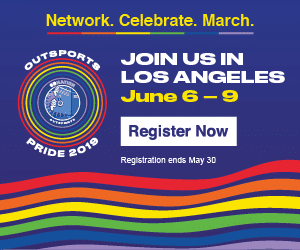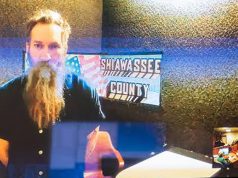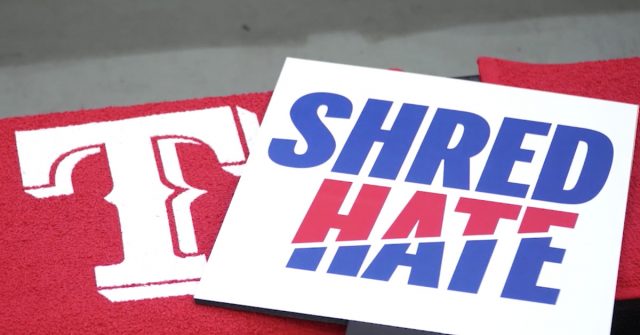
Major League Baseball is a partner in an extraordinary effort with the X Games, ESPN and baseball teams like the Texas Rangers, sharing an affirming and important message with young people: they should stand up to bullying, they should choose kindness over hate, and they should treat others the way they would like to be treated.
On Tuesday, Rangers pitcher Adrian Sampson. former MLB players Billy Bean and Mark McLemore took part in the latest hour-long anti-bullying rally, speaking to students at Pinkston High School in Dallas. It’s the campaign to “Shred Hate.”
“Shred Hate”
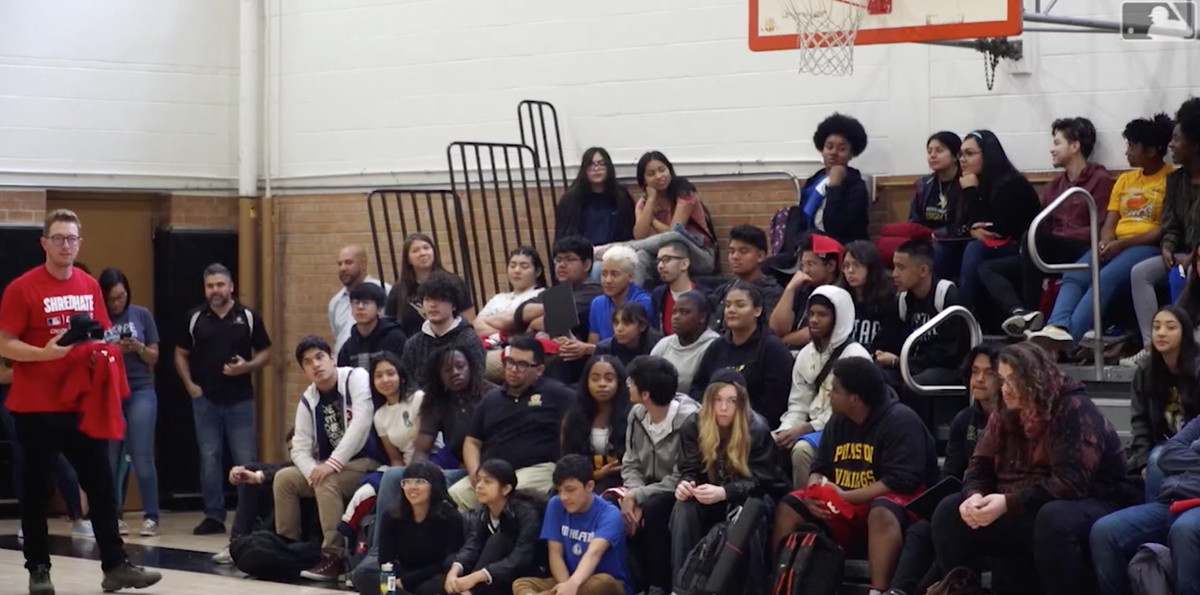
Rangers pitcher Adrian Sampson urged students at Pinkston High School to “Shred Hate.”MLB
The campaign is a bullying prevention program designed by a San Francisco nonprofit called No Bully, and its mission is to reduce bullying in schools nationwide.
No Bully has been doing this critically important work for a decade, CEO Will McCoy told Outsports. MLB’s website says that since its founding in 2003, No Bully has had a better than 90% success rate eliminating bullying in schools, and has served more than 325 schools, 202,000 students and 16,000 teachers. The org’s focus is on empowering voice and teaching compassion toward others and inclusivity. And the program is free to schools that take part, thanks to funding by ESPN, X Games as well as MLB and the individual ballclubs.
Bean, who came out in 1999 — the same year that Outsports debuted — oversees the MLB’s part in the “Shred Hate” program as vice president and as special assistant to MLB Commissioner Rob Manfred. He splits his time between major league clubhouses and communities, making the case for greater acceptance.

Billy Bean, MLB vice president and special assistant to the CommissionerMLB
“This is about creating environments that are accepting,” Bean told MLB. “You don’t have to march in an LGBT parade, you don’t have to go out of your way, but what you say and what you do … if boys like to call other boys the ‘F’ word, I’m trying to eliminate that in our sport. These kids are going to imitate what these players do.”
“This is the most important event we do this year,” Sampson told MLB. “This is probably the one we have to pay the most attention to. This is our future, right in front of us.”
According to MLB, the Rangers plan to host students in grades kindergarten through 12th grade, from all 18 schools in the Dallas area that participate in the “Shred Hate” program as well as student-athletes from the Texas Rangers MLB Youth Academy.
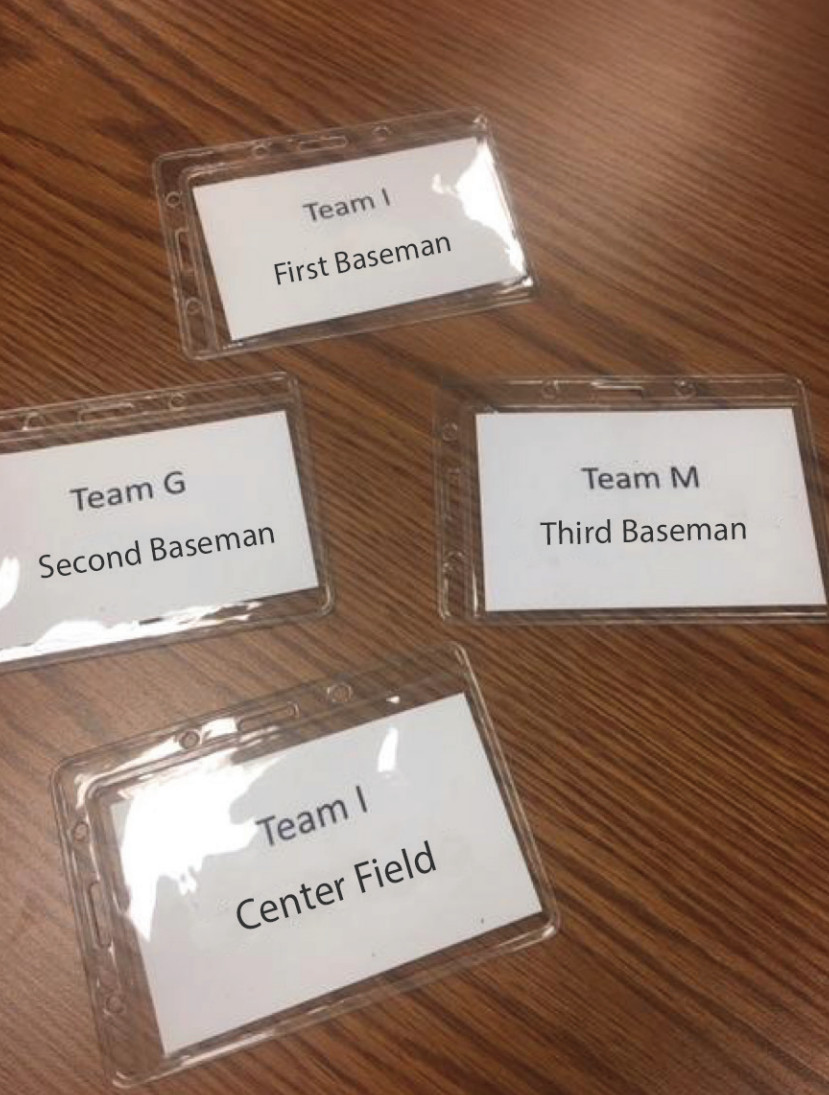
“Shred Hate” name tagsNo Bully
Before students attend the rallies, they take part in classroom scenarios that require them to role play. Each one is given a name tag and assigned to a team and a position, just like in baseball. The lesson plan tells instructors to say, “Batter up!” to begin the exercises, or “Bottom of the 9th!” when time is up.
The kids learn there are four kinds of bullying, according to the No Bully lesson plan: physical bullying, verbal bullying, cyberbullying and relational bullying.
The program varies depending on the children’s ages. Scenarios for the students in 4th grade through senior year of high school revolve around fat-shaming, hygiene, insults like “geek,” “loser” and “doofus,” mocking people who stutter, who are taller or shorter than average and those who wear hand-me-downs.
While all those themes can be intersectional, the current lesson plan used in the “Shred Hate” program does not include any elements specifically related to people who are LGBTQ, even though McCoy said his leadership team of ten people includes members of the LGBTQ community.
Left out
Not once does any scripted exercise address the bullying I personally recall all too well; I now joke that as a totally uncoordinated little leaguer, my position on our team was “left out.” Teammates and classmates noted how effeminate I was, and would call me “faggot” as well as “fairy,” “gay” and “girl”; it turns out only the last one was accurate.
That’s not a complete list, but suffice to say, the kind of bullying many members of the LGBTQ community experience is sadly absent from the scripted portion of the “Shred Hate” program.
“That was the first iteration and we’re continuing to iterate and improve,” McCoy told Outsports. “We are working on it and we will be consulting with folks like Billy Bean.”
Bean explained that No Bully’s lesson plan leaders — known as “solution coaches” — are free to tailor the lesson to accommodate students who want to share their own stories of bullying, whether it be about sexual orientation, gender identity, faith or race. Religious and racial conflicts are also not directly addressed in the “Shred Hate” lesson plan, and that is by design, said Bean.
“The core of all bullying prevention education is about inclusiveness,” Bean told Outsports. “So when you’re talking about isolating a curriculum for a specific gender, or for sexual orientation, or race, or religion or language, that that creates division.” The goal, he said, is trying to create a common ground. And as McCoy explained, that work is done behind the scenes, and does include LGBTQ and other issues not included in the lesson plan.
“We do deep levels of professional development at the school, with all the adults, which is where we feel we can best effect change,” McCoy told me. “And so we use that in our trainings, and we address LGBTQ issues within our trainings at the school sites. ‘Shred Hate’ is the overall campaign, but then if you look deeper at the work that we do in schools, we absolutely have to address all types of differences,” including LGBTQ.
That is a relief, and a welcome one, to my mind. But I cannot help but wonder if the reason the lesson plans don’t currently include intersectional scenarios like LGBTQ or racial bullying is because in some parts of our country, parents would freak out if they learned their kids were taught not to hate gays, trans people and people of color in school.
What’s still missing
Another issue I have with “Shred Hate” is that with the exception of Bean, none of the active and retired MLB players who share their stories about how they were bullied when they young identify as LGBTQ — because there are none living who are out. And, to boot, they’re all cisgender.
You can watch MLB’s video featuring Texas Rangers pitcher Adrian Sampson at Tuesday’s “Shred Hate” presentation in Dallas by clicking here.
Seven months ago, another Texas baseball player recorded a video for the campaign: Astros slugger George Springer — who last month was disciplined by MLB for calling an umpire who called him out on strikes a “fucking cocksucker.” Springer spoke about being bullied for his childhood stutter in his video.
His, and the other players’ videos and the rallies that follow the lesson plans are all indeed motivating, but they are missing a key element: us.
“Well, it’s not currently in the lesson plans, but if you look at our platform and the way that we present ourselves, it is about acceptance. That is the general broad theme,” McCoy told Outsports, when I asked him about the lack of LGBTQ-relevant content.
The good news is that he said his organization is working “to make sure that we represent everyone. But certainly, that’s a consideration when we’re developing materials moving forward, and our lesson plans and things of that nature, because we do know that the demand exists, and we are sensitive to it.”
McCoy was at Tuesday’s assembly in Dallas, when McLemore invoked the example of Jackie Robinson and how he used his bat instead of his mouth to respond to the racial taunts hurled by fans and opposing players.

Mark McLemoreMLB
“There is still something to learn from that. He still has a lifelong message to turn the other cheek and treat others the way you want to be treated,” McLemore told MLB. “He showed them who he was, his character. And that’s what this is all about … to stamp out hate any way you can.
“The best way, in my opinion, is to kill them with kindness. That shuts them down from all the negativity and all the hate and opens them up to, ‘Hey, maybe I should get to know this person before I start throwing all this stuff out there.’”
“The best way?” Mr. McLemore, you know a lot more about baseball than I ever will, and I recognize this speaking appearance was a one-off, not your day job. But please, no, showing bullies kindness and turning the other cheek is not always “the best way.”
I think he’s on the right track with that “getting to know this person” suggestion, but how about we teach students that they are the ones who should work to “get to know” the victims of bullying, instead of recommending they cross their fingers that bullies will respond positively to polite conversation.
The truth: Jackie Robinson gave no fucks
To expand upon McLemore’s example, it’s well-known that Jackie Robinson countered hate by letting his bat do the talking. But that’s because he knew that his career in major league baseball would end very abruptly if he were to respond to hecklers, or get into a fight with players who objected to a black man “infiltrating” the game.
What history has mostly forgotten is that Robinson had a notorious temper that he had to keep in check not only for the good of the game but for his own future.
Prior to becoming a Brooklyn Dodger, Robinson served in the U.S. Army, and the website How They Play has an instructive story that happened at a spot 2 1⁄2 hours south of Dallas, Texas.
In 1944, Robinson was traveling on a military bus to Fort Hood, when a white woman passenger complained about where he was seated. The bus driver told Robinson he had to sit in the back of the bus, even though the military had recently desegregated its buses.
“I’m not going to move a fucking bit,” Robinson reportedly said, and he told the woman, “You better quit fucking with me.”
The man who would become the paragon of virtue on the baseball diamond refused to give up his seat and was arrested by military police and court-martialed, but later acquitted. Robinson fought the charges and stood up for himself, and in spite of his foul language, his right to not give up his seat was affirmed.
The example usually shared with young people is that Robinson remained silent and relied on his teammates like Pee Wee Reese to stand up to bullies and racists who taunted him. But an LGBTQ-savvy lesson planner would include the bus incident, and how four decades later, in 1987, New York City activists who fought for government research into what would become known as AIDS launched the ACTUP campaign, and argued “Silence = Death.”
Bullying is just the beginning of hatred
The backdrop to Tuesday’s assembly in Dallas is that the police force there is investigating the murders of two transgender women and the stabbing of a third. Nationwide, at least five trans people have been murdered so far in 2019. and at least 26 were killed last year, according to HRC. And it’s not just the trans community who are at risk from violence: statistics from the FBI show a spike in hate crimes across the country. One group says those grim stats “grossly misrepresent” the true number of bullying and assault cases in the U.S.
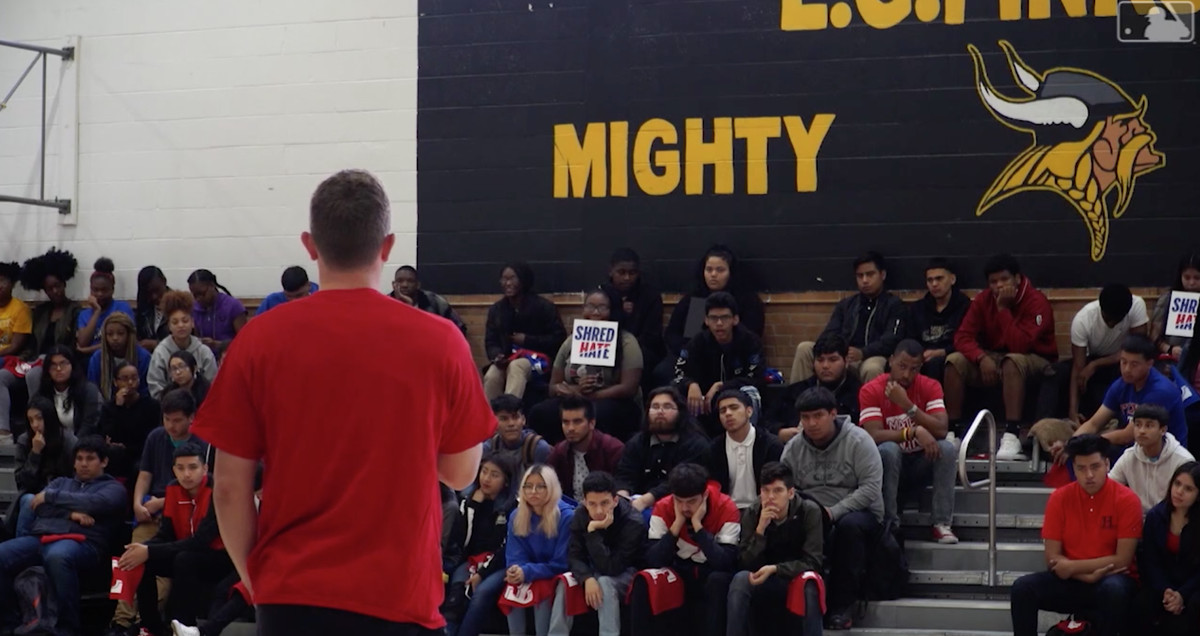
Pinkston High School, Dallas, Texas, Tuesday, May 21, 2019MLB
So to combat that, let’s teach our youth to do more than “kill them with kindness.”
Get to know us
The solution coaches for “Shred Hate” should tell the young people in Dallas and everywhere that they should do more than just stand up as an ally for their lesbian, gay, bisexual and transgender classmates. Tell them that they should get to know them and appreciate them for who they are, rather than shun them for being different.
What’s required is effort and action. Yes, be kind, and recognize that bullies are often themselves victims of bullying and that “hurt people hurt people.” But also, take action. Step up. Do more.
From what I’ve seen, I think “Shred Hate” is a great strategy to combat bullying, from its assemblies with famous speakers to the intensive lesson plans in our schools. All that is awesome.
But imagine how much better it would be to teach young people about this by bringing the bullied front and center.
Give the microphone to out and proud LGBTQ youth who can relate to today’s teens about their experiences with bullying, how to counter it and how to survive it. And go beyond baseball, to recruit the many out athletes competing in other sports who would welcome the chance to pitch-in with this anti-bullying effort.
At the end of our conversation about “Shred Hate,” Bean personally asked me for names, and he will get them. Can I add yours?
I say that we, the members of the LGBTQ sports community, can best show young people the impact bullying has, because we’re the ones who are still living it.


